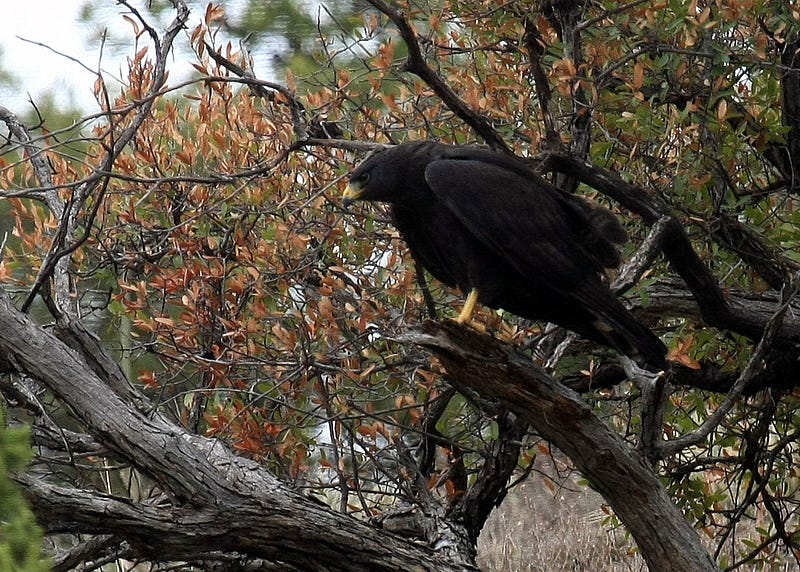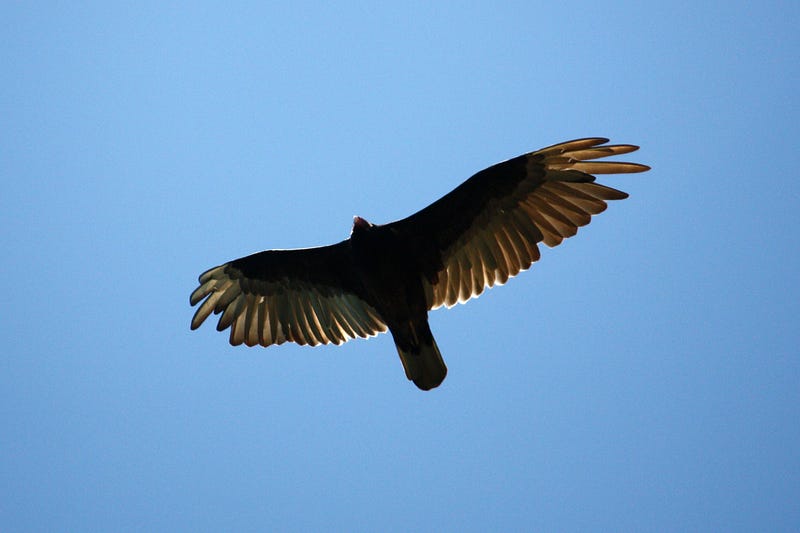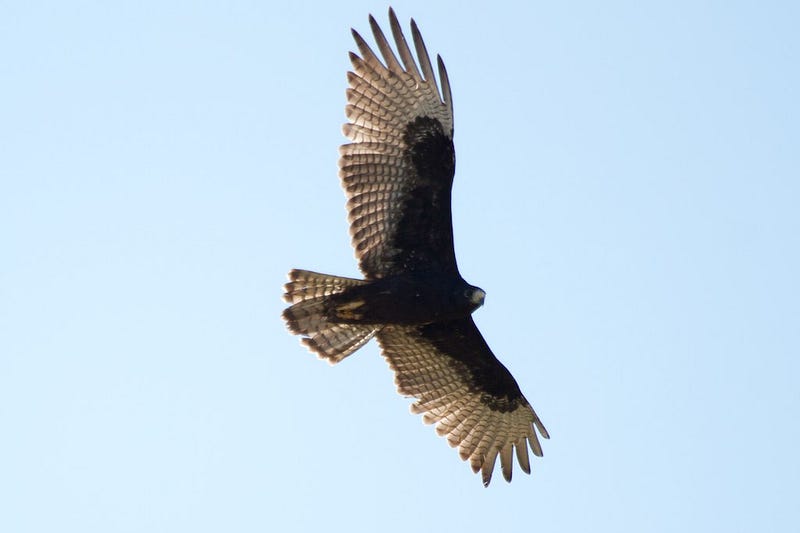
The key to aggressive mimicry is being able to lull your target into a false sense of security. The last two weeks the mimic accomplished this by imitating a helpful individual, either a potential mate or a mutualistic symbiote. However, it can also be done by mimicking a neutral organism, such as the turkey vulture, Cathartes aura, pictured above. The vulture is a carrion feeder, almost never actually killing prey itself. Instead it uses its powerful sense of smell (a rarity among birds, whose olfactory abilities tend to be minimized) to detect the gases emitted by fresh decaying carcasses.
It can be found throughout the Americas, including all of South America and much of non-Arctic North America, though in more temperate regions of that continent only in summer. Their scavenging plays an important ecological role by removing a potential breeding ground for diseases. But what species would benefit from mimicking the turkey vulture?

This is a zone-tailed hawk, Buteo albonotatus, a medium-sized hawk that preys on a wide variety of species, mainly small birds and mammals but local preference variations exist. It can be seen in parts of southern Arizona and New Mexico and western Texas, proceeding south through inland Mexico, Central America and western South America. However, you might be thinking that these two birds don’t look all that similar to one another, especially considering the lack of feathers on the vulture’s head (it eliminates the need to clean rotting carrion out of its feathers after being neck deep in a carcass). Can the predatory hawk really mimic the non-threatening vulture? Let’s look at them from another angle.
Many birds of prey (and despite its carrion eating ways, the turkey vulture is still considering to be one) along with sea birds and a handful of others conserve energy in flight by soaring. This is done by extending the wings and using air currents to keep aloft. Most commonly, these birds use thermals, a column of rising air caused by differences in solar heating of the Earth’s surface. The hot ground heats the air above it. Hot airs rises naturally and will continue to do so until it equalizes with the surrounding air temperature. This creates a localized updraft that birds can use to gain altitude without much effort. Once they reach the desired height, they can exit the thermal and glide down until they need to rise again.
Soaring turkey vultures are a common sight here in Florida, as well as throughout their range, because they tend to fly in large groups called ‘kettles’. Zone-tailed hawks, on the other hand, are not a social species and tend to be solitary hunters. However, because it has no detrimental effect on the vultures, a hawk can easily infiltrate such a kettle and fly alongside the turkey vultures. At this point, potential prey would be looking at the underside of the soaring birds instead of side-on at rest. Can you tell the difference between the two soaring birds below (try to do it without peaking at the captions if you can)?


I suspect most of you were able to tell the difference, but look at how subtle those differences have become compared to the first pair of photos. The different shape of the head, the stripe on the hawks tail, these are harder to spot, especially when you consider that even low-level flight is usually 10 to 30 meters off the ground, so you won’t have such a close-up view. The two species even share the same v-shaped wing positioning and the flight style of rocking from side to side. Increasing the complications for a prey species to be able to identify the hawk are the relative social differences mentioned above. More than likely, it will not be a single bird that the prey must identify, but an entire group of them where most are the model species.
As with the earlier stories, imagine yourself in place of the duped organism. You could be a small bird or mammal such as a cardinal or chipmunk, or possibly a small lizard. You see a group of dark-colored soaring birds with light under-wing flight feathers. This is a common sight and does not generally connote danger. Turkey vultures are scavengers, not predators. This means that you are more likely to reduce your overall vigilance in their presence. It is that behavior that the zone-tailed hawk exploits. It is unlikely that you will be able to tell that there is a predator mimic in the midst of the neutral scavengers, at least until it breaks cover and dives at you. Capture and death are still not guaranteed, but this mimicry gives a great advantage to a raptor that does not possess the size to take down larger and slower prey, or the stealth capabilities of something like an owl to avoid detection as it hunts.
A prey species that spots a predator, especially one out in the open like a soaring hawk, will go to ground if it can and hide until the threat passes. By mixing in with a similar-looking non-predator species and mimicking its behavior, the hawk gets more chances at catching prey. Such an individual is more likely to be able to survive, reproduce, and successfully care for its young and thus pass down the genetic traits that reinforce that mimicry.
We are getting to the tail end of Season 4, but there are still three more fascinating stories I want to share with you to bring this topic to a close. If you like my stories, please like, subscribe, and share them. If you have an idea for a topic for a future season, let me know and if I use it, I’ll give you a shout out in my introductory post.